Abstract
As concerns about sustainable energy solutions grow, the exploration of bio-inspired techniques for optimizing renewable energy systems becomes increasingly important. This study presents a theoretical application of bio-inspired algorithms, specifically the Particle Swarm Optimization (PSO) algorithm and the Genetic Algorithm (GA), to enhance the energy availability of a renewable energy system in an existing university building in a tropical climate. The research followed a multi-step process. First, a renewable energy generation system was designed for the building, considering available resources and space limitations. Next, we optimized both electricity production and overall energy management. Using the PSO algorithm to find the ideal combination of power generators that would fit within the available space resulted in a 10% increase in the energy deficit. Additionally, PSO was used to optimize the discharge management of the battery bank, independently demonstrating a 2% efficiency improvement when incorporated into the original pre-optimization system. These findings highlight some of the challenges with integrating renewable energy systems into existing buildings while showcasing the potential of biomimetic algorithms, like the PSO and the GA, for targeted optimization tasks. Further research is warranted to refine such algorithms and explore their tailored applications for enhancing the performance of renewable energy systems within the often-restrictive parameters of existing infrastructure.
1. Introduction
Nature may offer practical solutions to the energy challenges we face today. Biomimicry, which involves observing and emulating nature’s efficient systems, is increasingly recognized for its potential to enhance energy generation [1]. As we grapple with diminishing resources and environmental concerns, the need for sustainable and adaptable energy systems becomes critical [2], and biomimicry provides a compelling pathway to achieve these goals [1].
This approach enables us to develop energy solutions that are both effective and environmentally friendly. Examples include innovative designs such as solar panels that mimic the functionality of leaves and wind turbines designed after whale fins, which clearly demonstrate how nature’s designs can be adapted for energy efficiency [3]. Biomimicry is more than just copying natural forms; it is about understanding and applying the principles that make these forms so effective. Embracing this concept, known as “solution-based biologically inspired design”, could lead to a wide range of innovative energy solutions [4]. Despite its potential, biomimicry in energy generation faces challenges. The complexity and variety of nature’s solutions necessitate careful selection and adaptation to meet the specific energy needs [5], demanding creativity and technical ingenuity to bridge the gap between the natural world and technological applications. However, the potential benefits of biomimicry far outweigh these challenges.
Recent research in this field highlights the diverse applications of biomimicry across various energy generation methods, ranging from solar and wind energy to hydropower and biomass. Crucially, this research increasingly focuses on optimization as a key area for advancement with biomimicry contributing to intelligent energy management. Incorporating hybrid renewable energy sources and advanced algorithms, such as machine learning and bio-inspired optimization techniques, enhances the efficiency of energy production and distribution, ensuring optimal utilization of resources.
Sustainability is another crucial aspect of biomimicry in energy generation. This approach fosters solutions that minimize environmental impact and promote resource conservation, often integrating closely with solar energy initiatives and circular economy principles. These solutions focus on creating closed-loop systems and responsible resource management. Interestingly, the trajectory of biomimicry research is evolving. While the overall emphasis on biomimicry has seen a slight decline, areas like optimization are growing rapidly [6]. Researchers are exploring bio-inspired strategies for smart energy management [7]. Additionally, the focus on renewable energy sources, particularly solar and wind, remains a strong focus [8].
This shows biomimicry is maturing, moving from exploration to focused application in areas with high potential for improving energy systems. By learning from nature, we can create a future powered by energy systems that are efficient, sustainable, and adaptable [9]. The challenges are significant, but the rewards—a healthy planet and a secure energy future—are worth it. This research demonstrates the potential of Particle Swarm Optimization (PSO) and the Genetic Algorithm (GA), both bio-inspired algorithms, to optimize energy generation in tropical buildings. Our findings show that success depends on optimal energy management. Future research will aim to refine these optimization techniques further and address the challenges posed by limited space availability for renewable energy equipment.
This paper is organized into six different sections, along with an appendix and a list of the references used for it as follows: introduction, literature review, materials and methods, results analysis, discussion, and conclusions. The main objectives of this study are presented in the Problem Definition and Understanding portion of Section 3.
2. Literature Review
As outlined in the overview, the first step was to conduct a bibliometric review, which we would then use to determine the course of the project. The first step was to identify key words necessary to find the relevant research papers. These key words combined different energy sources with the words biomimicry, nature-based, and bio-inspired. There were five databases used for compiling the articles—ScienceDirect, SCOPUS, MDPI, JSTOR, and SpringerLink—but only open-source articles were used. A total of 615 unique papers published between 2015 and 2022 were found. Duplicate papers, found across multiple databases, were removed using Mendeley Reference Manager’s duplicate removal feature.
From this set, we selected several to illustrate some of the common biomimicry strategies used in the literature, as shown in Table 1. Examples include the use of humpback whale pectoral fins in hydroelectric energy, applying compound insect eyes to improve solar panels, and employing palm tree root systems to build taller wind turbines. The most important takeaway from this showcase of how varied these solutions is that in biomimicry there is no one correct choice, but many possibilities that need to be explored further.

Table 1.
Common biomimicry strategies used in literature.
The selected papers were processed using VOSviewer version 1.6.18 to create neural maps showing the tendencies in the literature, by using the key words from each of these papers. The first map is shown in Figure 1.
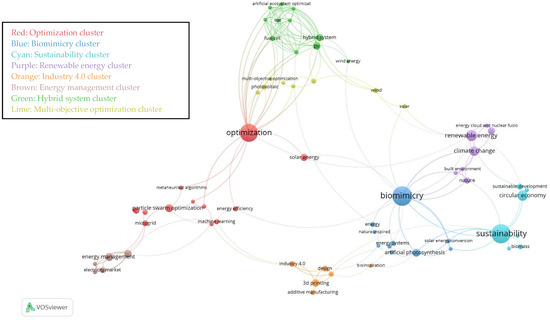
Figure 1.
Neural map created from the review articles.
There are a total of eight clusters on the map; the size of each circle is an indication to how relevant each key word is in the literature: “optimization” (red), “biomimicry” (blue), and “sustainability” (cyan). The biomimicry cluster is tightly linked to renewable energy concepts like “renewable energy systems”, “artificial photosynthesis”, and “solar energy conversion”. Sustainability, in turn, connects closely to both biomimicry and concepts like “circular economy”, “sustainable development”, and “biomass”. Notably, the optimization cluster, while distinct, associates with terms such as “machine learning”, “energy efficiency”, “energy management”, “industry 4.0”, and “hybrid systems”. Solar and wind energy appear as relevant topics across all three clusters.
Figure 2, which guides this project, maps these keywords and uses color to represent relevance over time, providing a temporal perspective on the literature.
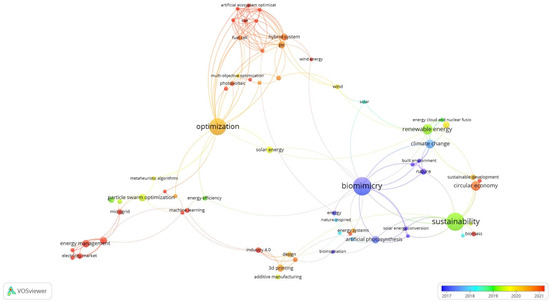
Figure 2.
The neural map created from the review articles, showing relevance over time.
This map illustrates the evolution of key themes within the literature over the review period (excluding 2015–2016 due to limited publications and the partial year of 2022). While biomimicry saw peak relevance in 2017 and sustainability in 2019, the 2020–2021 period, most relevant to this study, reveals a distinct shift. Research progressed from an initial focus on biomimicry, then towards optimization (dominant in 2020), and subsequently towards energy management and Industry 4.0 applications (2021). Notably, solar and wind energy consistently remained relevant throughout the entire period. This observed trend, the increasing prominence of optimization within biomimicry research, particularly in the context of renewable energy, directly informed the focus of this study: biomimetic-based optimization of a distributed renewable energy generation system for an existing building. Therefore, based on this bibliometric analysis highlighting the clear trend towards optimization methods, particularly their dominance in the recent 2020–2021 period within biomimicry and renewable energy research, the methodological focus of this study was established as the biomimetic-based optimization of a distributed renewable energy generation system for an existing building.
3. Materials and Methods
The methodology for the actual research, which is what makes up Section 2, Section 3 and Section 4, comprised five fundamental phases, focusing on distributed renewable energy generation and biomimicry:
- Literature Review: We initiated our research with a thorough bibliometric review to analyze global trends, advancements, and potential knowledge gaps in the fields of renewable energy and biomimicry. This analysis helped us identify promising research directions and potential areas for innovation within the sustainable energy sector.
- Problem Definition and Understanding: Based on the literature review, we formulated clear research objectives and the methodology to achieve them. This involved defining the parameters of our case study, ensuring the research remained focused and achievable within the defined time and research budget constraints.
- Design of the Generation System: We designed a site-specific hybrid wind–solar distributed energy generation system with a battery bank for building #1 on the Víctor Levi Sasso Campus of the Universidad Tecnológica de Panamá (UTP). This design prioritized the building’s physical space and considered factors such as local climate conditions, energy usage patterns, and available resources to optimize the system’s configuration.
- Identification of Optimal Management: To enhance the efficiency and sustainability of our designed hybrid system, we used a biomimetic-inspired algorithm. Utilizing software tools such as MATLAB (ver. 9.10.0.1602886) and Python (ver. 3.11), we implemented optimization techniques that aimed to improve energy management and resource utilization.
- Performance Evaluation: We conducted a comparative analysis between the performance of the biomimicry-optimized system and a non-optimized baseline. This evaluation allowed us to quantify the improvements achieved in terms of energy efficiency, measured by the energy deficit in both cases.
Figure 3 contains a flowchart of the methodology process for easier viewing:
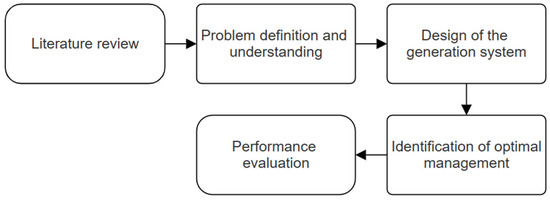
Figure 3.
Methodology flowchart.
3.1. Problem Definition and Understanding
The selected case study is building n°1 at UTP’s Víctor Levi Sasso Campus in Panama City, Panama (9°01′26″ N 79°31′52″ W) as shown in Figure 4.
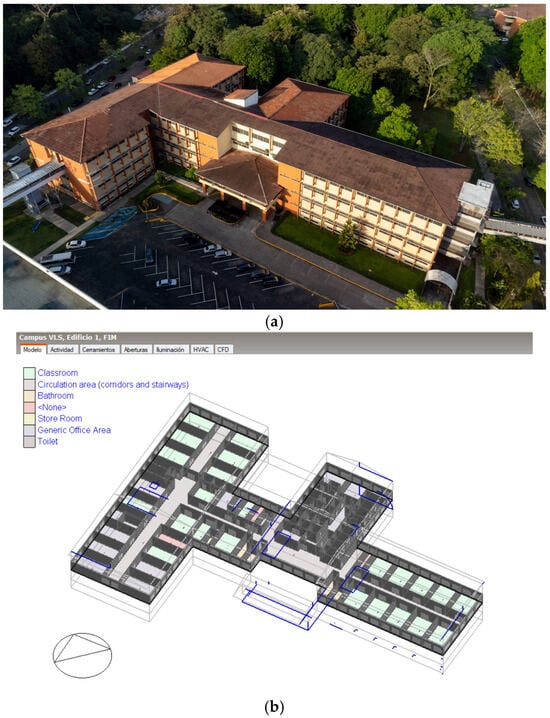
Figure 4.
(a) Building n°1 of the Víctor Levi Sasso Campus of the UTP and (b) section showing one of the floors of the building n°1 3D model in DesignBuilder.
Historical climate data were obtained from the Solargis ® Climate app database. These data represent average weather records from 1999 to 2019, averaged into a typical year. According to the Köppen climate classification, the building is located in an urbanized area bordering tropical forest. Table 2 presents climate data from this typical year, with each entry showcasing the day with the peak temperature for that month.

Table 2.
Climate data summary for the case study simulations.
A significant advantage of selecting this building was the DesignBuilder model. This model enabled energy simulations to obtain data on energy demand and solar generation. We also had access to the building’s construction details, shown in Table 3 and Table 4, provided by the General Directorate of Engineering and Architecture (DGIA), which provided a thorough understanding for the simulations.

Table 3.
Construction details of building n°1.

Table 4.
Energy use and operating hours.
Energy simulations were performed in DesignBuilder, using EnergyPlus. The model, which incorporated actual building divisions, provided detailed data on the building’s energy needs. These simulations considered key parameters such as student occupancy, building materials, and energy use patterns. A section showing one of the floors of the building model is shown in Figure 4b. Figure 5 shows the energy building’s energy demand by category.
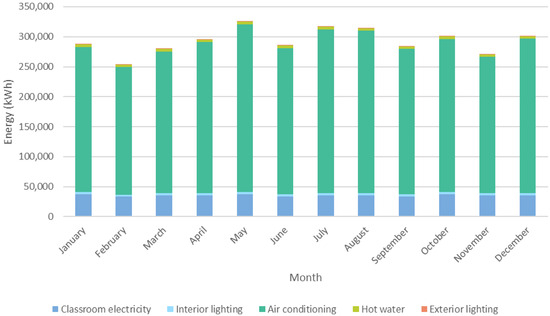
Figure 5.
Building energy demand per month and usage.
3.2. Design of the Generation System
The generation system combined wind and solar energy, taking into account the building’s specific location conditions and energy needs. We prioritized technical aspects over economic factors.
- Wind Generation System Sizing: The RenovaWind EOS 1 kW [30] turbine was selected for its rooftop suitability and omnidirectional operation. Using the Weibull wind frequency method, we estimated the wind generation capacity and allocated a space of 350.26 m2 for 9 turbines. Each turbine has a rated power of 1000 W.
- Solar Generation System Sizing: SunPower SPR-A450-COM [31] panels were selected for their high efficiency and suitability for the available rooftop space. After accounted for area occupied by wind turbines, 3521.86 m2 remained for solar panels. The generation capacity was calculated using the Installed Power method, considering optimal panel orientation and inclination. Each panel has a rated power pf 450 W.
- Conventional storage system (Battery Bank Sizing): Tesvolt TS25 [32] batteries were selected for their efficiency and reliability. These modular batteries can be expanded in 4.8 kW increments. However, it could be replaced with another storage system. Based on the highest daily combined energy generation, a total of 13 battery units are required to store the surplus energy generated during off-hours.
3.3. Optimization Setup
The project’s primary focus was using a bio-inspired algorithm to optimize the system. We reviewed various bio-inspired algorithms, including Bacterial Foraging Algorithm (BFA), Particle Swarm Optimization (PSO), Genetic Algorithm (GA), and Ant Colony Optimization (ACO), assessing their suitability for optimizing our generation system. These algorithms were chosen for their relevance, effectiveness, and alignment with our research objectives. Ultimately, the Particle Swarm Optimization algorithm was selected due to its prevalence in the literature and relative ease of implementation, both in terms of Python code simplicity and computational demands. After obtaining results using PSO, we used GA for the second optimization instance to further evaluate the viability of this approach.
A comprehensive statistical analysis of energy flows within the case study building was performed, followed by system optimization using the PSO algorithm. The goal was to understand the building’s energy consumption patterns, including contributions from solar and wind power. The methodology comprised the following steps:
- Data collection: We gathered energy-related data from separate sources. DesignBuilder simulations provided building energy demand and solar generation data, shown in Figure 4. Since DesignBuilder is unable to simulate wind generation, a MATLAB script was written to simulate it, considering the on-site historic weather data, power curves from the turbines, and other relevant parameters.
- Descriptive statistics: We calculated descriptive statistics to summarize the dataset.
- Clustering: We used a k-means clustering algorithm to categorize data points exhibiting similar characteristics.
Analysis of the large dataset gathered from the previously described methods reveals several key insights. Combined solar and wind generation meet 33% of the building’s energy demand, while air conditioning dominates consumption at 85% of the total load. Most importantly, the analysis yields numerous figures, the most comprehensive of which is visualized in Figure 6, which shows the data from May 6th to 13th.
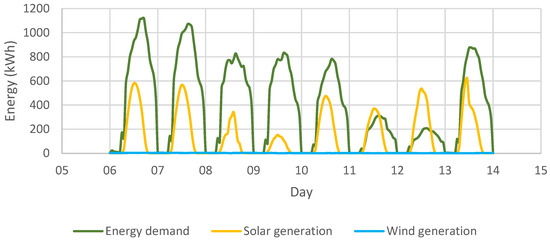
Figure 6.
Generation vs. energy demand, from May 6th to 13th, where May 11th and May 12th correspond to Saturday and Sunday, respectively.
The graph clearly shows that the energy demand significantly exceeds both solar and wind generation. Furthermore, wind generation is negligible compared to solar generation at this scale. We now turn to the comprehensive statistical analysis.
To understand overall system patterns in energy consumption and generation, a comprehensive analysis was performed using a Python script. This analysis encompassed all three system components (consumption, solar generation, and wind generation), although the figures presented here focus primarily on generation. Dendrograms were created using single, complete, and average linkage methods to explore the data clustering. Following Mora et al. [33], the complete-link method was selected. Figure 7 shows all three dendrograms generated for energy consumption.
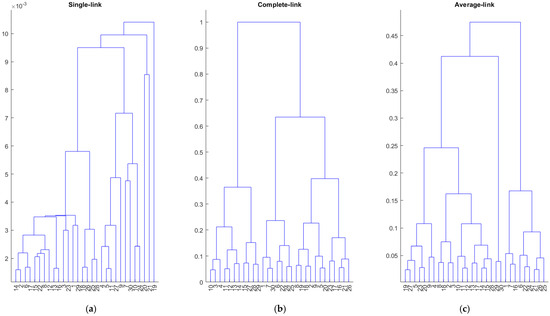
Figure 7.
Energy consumption dendrograms. (a) single link; (b) complete link; (c) average link.
These diagrams are like family trees, showing how hours with similar energy use patterns join together step-by-step. The dendrogram on the left (a) represents the single-link method, the dendrogram on the middle (b) represents the complete-link method, and the dendrogram on the right (c) represents the average-link method. The height of the lines on the chart shows how different the points or groups are when they merge. Looking at Figure 7, we can see the different methods might group the data differently—some might create long chains, while others create tighter clumps. These pictures help us decide the best number of clusters to use for our data. We typically look for a large vertical jump in the lines to find a good place to ‘cut’ the tree and count the main branches below as our clusters.
Following the creation of the dendrograms, a visual analysis is required to determine the correct number of clusters for the dataset. Table 5 shows the conglomerate number determined for each part of the analysis.

Table 5.
Number of clusters for each part of the analysis.
Once the appropriate number of clusters is known, the script goes on to allocate each data point into one of the groups, creating a scatter chart like Figure 8.

Figure 8.
Energy consumption scatter plot for the complete link method.
The initial analysis clustered hourly building energy consumption data, represented in a scatter plot where the vertical axis shows normalized consumption, and the horizontal axis represents the time of year in hours. Each color represents a distinct consumption pattern cluster. For instance, the largest cluster (purple) corresponds to periods of low energy use, while the smallest (red) indicates infrequent peak consumption periods. A similar scatter plot was generated for solar energy production. However, the wind generation analysis, shown in Figure 9, reflects Panama’s seasonal wind patterns, with higher generation typically occurring during the dry season. Figure 10 presents two bar graphs summarizing the clustering results: one displaying the centroid of each cluster, and the other showing the number of hours within each cluster.
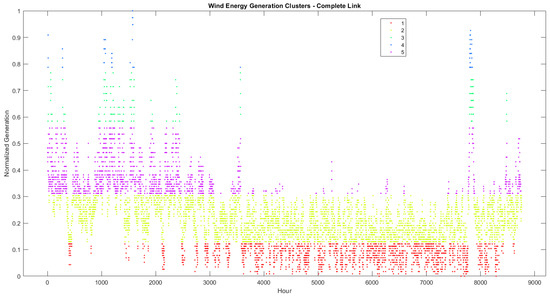
Figure 9.
Wind generation scatter plot for the complete link method.

Figure 10.
Energy consumption bar graphs for the complete-link method.
The cluster analysis generally reveals an inverse correlation between cluster size (number of hours) and centroid value (average consumption). Clusters 3 and 4 are exceptions, exhibiting a reversed centroid order compared to the overall trend. Despite these exceptions, the analysis effectively illustrates the system’s operational patterns.
3.4. Performance Evaluation
Having established this foundation, we now proceed to the core of the project: optimizing the system using a bio-inspired algorithm. Table 6 lists several options considered, based on literature review.

Table 6.
List of some existing bio-inspired algorithms.
The algorithm chosen for this project was Particle Swarm Optimization (PSO). This algorithm is inspired by the movement of flocks of birds and schools of fish. It offers several advantages: strong good performance across diverse optimization problems, a limited number of parameters to tune compared to other optimization algorithms [44], which simplifies the task of finding an effective configuration, and its generally relative ease of use. A Python library facilitates rapid implementation of a basic PSO algorithm without requiring custom coding [45], and the simulations run quickly. The algorithm works as follows [46]:
- PSO begins with randomly scattered particles within a search space. Each of these particles represents a potential solution and has parameters for both position and velocity.
- An objective function assesses each particle, determining the “fitness” of its current position.
- Each particle remembers the best position it has encountered, and the swarm collectively remembers the best position found by any particle.
- In each iteration, the particles adjust their velocities and positions according to a velocity update rule. This rule is influenced by the particle’s previous velocity, the best personal position, and the best global position.
- This process iterates until a stopping criterion is met, typically a user-defined maximum number of iterations.
We performed optimization in two areas: first, optimizing the distribution of the generators on the roof of the building, and second, optimizing the battery discharge rate. The first optimization determined the optimal mix of the pre-established number of generators. The second optimization used the algorithm to determine the best moments during the day to utilize stored battery energy, given inputs of generation, consumption, and other relevant data. This aimed to reduce the energy deficit compared to the original system.
The most important aspect of every optimization problem is the objective function; here, we consider two. Where E is energy, D is deficit, A is area available, and G is generation, Equations (1) and (2) represent the total energy generated by both the solar and wind parts of the system, respectively. This considers the area in square meters that each part occupies on the roof, and the generation per unit of area. This takes us to Equation (3), where the results from the two previous equations are used to calculate the energy deficit, by subtracting them from the energy demand of the building, and lastly Equation (4) is the objective function, which is the sum of the deficit in the given time of the project, the result of which must be minimized by the algorithm. Not shown in these equations are the limits enforced on these variables, which limit things such as the area of the roof that is available (0–3802.12 m2), an upper and lower limit for working wind speed for the turbines (5–14 m/s), a penalty given to the algorithm which forces it to remain within the previously defined area bound, the PSO variables were set at 100 particles and 1000 iterations of the optimization. An explanation for the work process of the written snippet in Python that performs this task is available in Appendix A, but a flowchart showing the basic steps is shown in Figure 11. The end result is that the algorithm indicates how much, in percentage, of the available space on the roof corresponds to the solar panels and wind turbines, respectively. These percentages are then converted to an actual number of solar panels and turbines.

Figure 11.
Basic steps for energy mix optimization code.
The PSO parameters were selected based on common practices and preliminary tuning: a swarm size of 100 particles was chosen for adequate search space coverage, 1000 iterations allowed for sufficient convergence time, and coefficients w = 0.9, c1 = 0.5, c2 = 0.3 were set to effectively balance global exploration and local exploitation for this problem structure. Area constraints (total limit, minimum wind, non-negativity) were managed using a penalty function approach.
The second stage of optimization focused on battery discharge management. It used data from the first optimization with the same PSO parameters, where variables with the same name depict the same information, but it could also incorporate data from other sources, such as DesignBuilder energy simulation results. Equation (5) calculates the energy deficit considering the battery discharge, and Equation (6) is the objective function. Similar to the first optimization, the Python code snippet explanation for this task is available in Appendix A and a flowchart showing the basic steps of the process is shown in Figure 12. The limits placed on these equations include the lower and upper bounds for battery capacity.
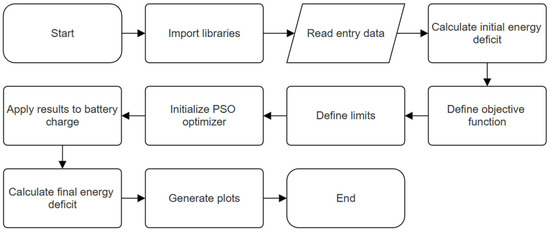
Figure 12.
Basic steps for battery discharge optimization code.
To further assess the viability of bio-inspired algorithms and inform future research, we subsequently applied the Genetic Algorithm. Given the superior results of the battery discharge optimization, as discussed in the next section, the GA was used solely for this purpose.
Building upon the initial analysis with PSO, the Genetic Algorithm (GA) was selected as an alternative bio-inspired method, primarily due to its recognized strengths in navigating complex optimization landscapes often encountered in energy systems management [47]. Unlike PSO’s particle trajectory approach, GA operates on a population of potential solutions, applying principles inspired by natural selection, including selection, crossover (recombination), and mutation. This approach helps GA search thoroughly for the best solution, making it less likely to get stuck on a ‘good enough’ answer instead of the optimal one. Getting stuck is often a problem when dealing with complex rules and interactions, like those involved in managing battery use with changing energy generation and needs. The ability of GA to maintain diversity within its solution population allows for broader exploration of the search space, increasing the likelihood of discovering fundamentally different and potentially superior operating strategies compared to PSO [47].
This simulation explicitly modeled and enforced battery constraints, namely the previously mentioned battery bank capacity and a 0.9 charging efficiency. GA parameters were chosen based on typical ranges and preliminary testing to ensure robust performance: a population size of 100, consistent with PSO for fair comparison and providing sufficient diversity for the high-dimensional problem, was evolved over 50 generations, found to be adequate for convergence in initial runs. Two-point crossover (probability 0.5) was selected to allow effective exchange of scheduling blocks, while Gaussian mutation (probability 0.2, sigma = 10, indpb = 0.1) provided necessary local search capability for the continuous nature of discharge values. Tournament selection (size 3) was used for its common effectiveness in maintaining selection pressure while preventing premature convergence. Figure 13a,b demonstrate an overview of how PSO and GA work at a basic level.
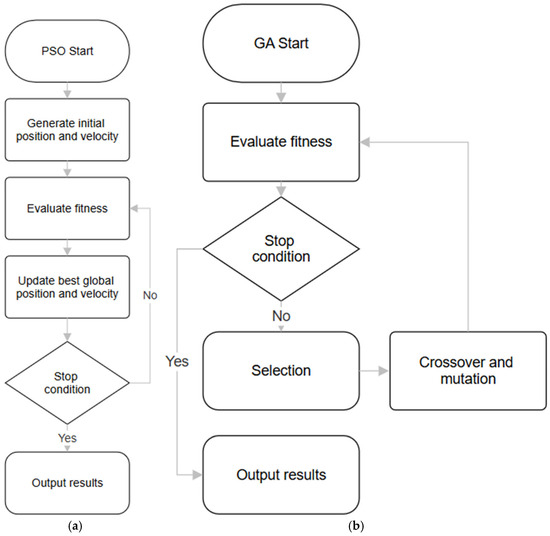
Figure 13.
(a) Particle Swarm Optimization flowchart. (b) Genetic Algorithm flowchart.
4. Results Analysis
The PSO algorithm, as implemented, uses 1000 particles in each iteration, with each particle attempting to find the optimal solution to the objective function. The algorithm runs for a maximum of 100 iterations per run. For the following results, we executed the program 10 times. Table 7 shows the results from this process.

Table 7.
PSO energy generator mix optimization results.
As shown in the table, the optimization resulted in a decrease in solar panels by 536 modules and an increase of 27 wind turbines. Vertical wind turbines offer a relatively fast return on investment [48] and, in theory, should provide greater generation at night, when the solar panels are inactive. Since the building’s demand is very low at night, this increased nighttime generation could provide surplus energy to be stored in the batteries for later use.
The code for the second optimization generates both numerical and graphical results, including the building’s energy demand, the original energy deficit, the battery charge level, and the final energy deficit. Figure 14 shows a sample graph displaying one week of data.

Figure 14.
Energy analysis for the May 6th to 13th week, where the blue line is the “manual design”, and the green line is the “optimal design”.
Figure 14 shows the building’s energy demand (gray line), the initial energy deficit (blue line), the battery bank charge level (orange line), and the final energy deficit (green line). Visual inspection of the graph suggests that the optimization has a limited impact on reducing the energy deficit. The graph also reveals periods, particularly on Sundays, where the energy generation exceeds the immediate demand. Quantified over the entire year, this surplus energy amounts to 45,613.10 kWh, representing approximately 15% of a single month’s energy demand, or 1.3% of the total annual energy demand. Figure 15, Figure 16 and Figure 17 represent the same data at annual, monthly, and daily scales, respectively.
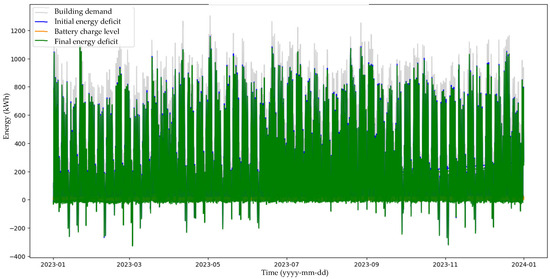
Figure 15.
Energy analysis for the whole year of this study.
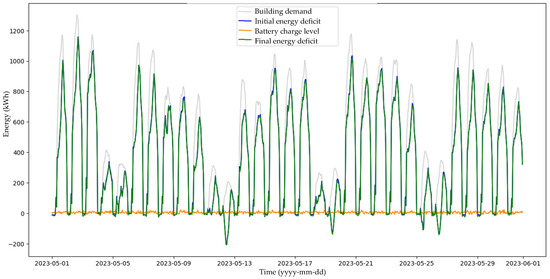
Figure 16.
Energy analysis for the month of May.
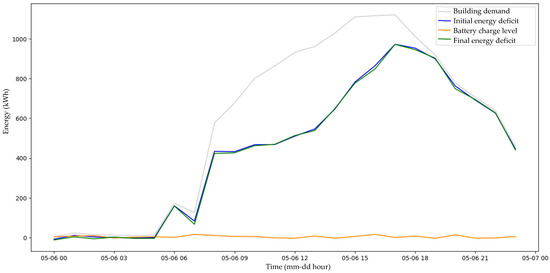
Figure 17.
Energy analysis for May 6th.
Next, we quantified the algorithm’s effectiveness in reducing the energy deficit, by comparing the optimized system to the original system. Table 8 shows the results from 10 iterations.

Table 8.
Results of decrease in energy deficit from 10 iterations.
The average energy deficit increase was 9.8%. This gave us some helpful lessons about designing these kinds of renewable energy systems. We started by focusing on obtaining the most energy per square meter, which made it seem like using only solar panels was the best idea. But the results showed us that we needed a more complete approach. Our first attempt only looked at maximizing power; it did not think about things like how much solar panels and wind turbines cost, how much we would have to pay for electricity from the grid when our system was not enough, or how suitable the actual building was for different technologies. The first try also did not fully consider that sunlight and wind change all the time, and that the building’s energy needs also change. PSO is a good method, but it can sometimes become stuck on a solution that is not really the best, especially with complicated problems. It also relies on some settings that need to be just right. And, because we did not build random changes into our model, the PSO may have been too focused on one specific set of conditions.
The last runs with the PSO algorithm were performed with the second optimization, without prior energy mix optimization, yielding different results. The graphsare visually similar with a more notable difference between the initial and final energy deficit curves. Quantitatively, this resulted in a 2% reduction in the energy deficit. The annual energy surplus (energy that would be wasted without a battery bank) was 92,992 kWh, representing 4% of the annual energy demand. The Genetic Algorithm was subsequently used in the same manner, with Figure 18, Figure 19, Figure 20 and Figure 21 showing the results from these runs:
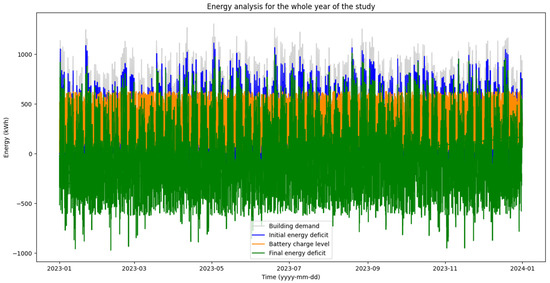
Figure 18.
Energy analysis for the whole year of this study, using the GA.
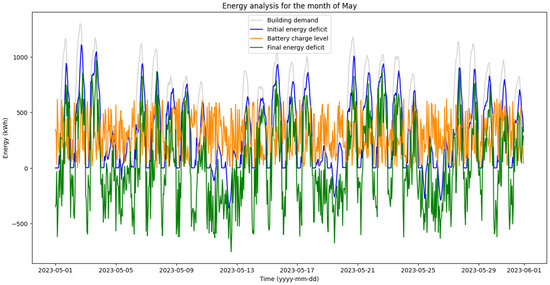
Figure 19.
Energy analysis for May, using the GA.
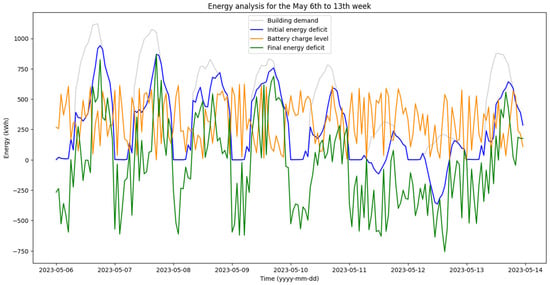
Figure 20.
Energy analysis for May 6th to 13th, using the GA.
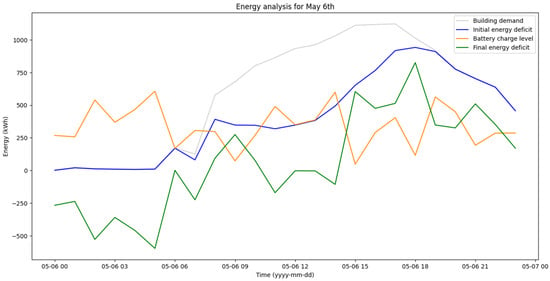
Figure 21.
Energy analysis for May 6th, using the GA.
The Genetic Algorithm (GA) produced significantly different results compared to Particle Swarm Optimization (PSO), highlighting the GA’s superior ability to navigate the complexities of this particular optimization problem. The GA’s suggested strategy involved storing all generated energy in the battery bank and discharging it as needed. While this approach, in a real-world implementation, might raise concerns about long-term battery health and efficiency losses due to charge/discharge cycles, it demonstrably reduced the energy deficit more effectively within the simulation. The initial energy deficit of approximately 2,333,160 kWh was reduced to approximately 2,241,025 kWh, a 4% decrease—roughly double the improvement achieved with the initial PSO implementation. This superior performance could be attributed to several key differences between the algorithms:
- Better Exploration: GA explores many possible solutions at once, like trying out lots of different designs. PSO focuses on improving a single solution, which can make it become stuck on a design that is not truly the best.
- Built-in Advantage: GA naturally favors solutions that perform better overall, even if we do not explicitly tell it all the rules. It is like natural selection—the “fittest” solutions survive.
- Handles Complexity Better: GA is better at dealing with all the complicated ways that solar power, wind power, batteries, and building energy use interact. PSO can struggle with these complex relationships.
5. Discussion
This research project explored bio-inspired optimization for energy management in buildings. While the combined optimization efforts increased the energy deficit by nearly 10%, this outcome highlights several key considerations:
- Space Limitations: The system was constrained by the available space on an existing building. Because of this restriction, the manually designed generation system could only meet approximately 33% of the building’s energy demand, though this does meet certain European standards for renewable energy integration in existing buildings [49]. This emphasizes that retrofitting existing buildings with renewable energy systems often faces physical limitations. Project developers and policymakers need to set realistic expectations about the achievable level of energy self-sufficiency based on available space.
- Economic Factors: This project prioritized technical performance over economic factors. Future studies should include other parameters such as equipment cost and return on investment, reflecting real-world implementation considerations, as demonstrated in similar studies [48]. This means that optimization should not only focus on energy production but also on minimizing overall costs.
- Optimization Focus: The energy mix optimization, based solely on generation per square meter and rated power, negatively impacted the energy deficit when combined with the subsequent battery discharge optimization. However, applying the battery discharge optimization to the original non-optimized system did yield a positive result of 2% reduction in the energy deficit. This demonstrates that optimizing individual components in isolation can be counterproductive. A holistic, system-level optimization approach is crucial for achieving overall efficiency gains. Designers should carefully consider the interactions between different system components.
- Algorithm Choice: Applying the Genetic Algorithm (GA) to the battery discharge optimization achieved a 4% reduction in energy deficit, double that of PSO. There is no one-size-fits-all optimization solution. Engineers and designers should experiment with multiple algorithms and carefully evaluate their performance based on the specific project requirements and constraints.
In summary, while optimizing the energy generator mix using Particle Swarm Optimization (PSO) decreased overall system efficiency by nearly 10%, using PSO for battery bank discharge optimization increased efficiency by 2%. The Genetic Algorithm (GA) further improved battery bank discharge optimization, achieving a 4% efficiency increase. These findings highlight the significant impact of both algorithm selection and the specific optimization target on overall system performance, emphasizing the need for diverse algorithmic approaches and consideration of system parameters in future research.
Negative optimization results, as observed in this study, are not uncommon in the literature. For example, Azad et al. [50] applied several bio-inspired algorithms to an energy generation problem, and one algorithm yielded negative results due to difficulties in handling nonlinear constraints. Similarly, Kohne et al. [51] found that some algorithms failed to optimize a system effectively because they struggled to balance cost optimization with constraints such as temperature limits and system stability. While the specific challenges encountered in those studies differ from those encountered with PSO in our work, these examples highlight the inherent variability in the performance of optimization algorithms and their sensitivity to problem-specific constraints and objectives.
6. Conclusions
This study investigated the intersection of biomimicry and renewable energy generation, specifically exploring how biomimetic-based algorithms—Particle Swarm Optimization (PSO) and Genetic Algorithm (GA)—could be applied to the design of a distributed energy system for an existing building in Panama. We designed and theoretically implemented a distributed renewable energy generation system for an existing building, using dynamic simulations to account for its physical space and operational characteristics. While our findings reveal both the shortcomings of the PSO algorithm in this particular application, the GA algorithm demonstrated potential performance improvements in this context. This success provides a tangible pathway towards more efficient and effective distributed energy system design.
This study’s findings have limitations affecting scalability and real-world application. The results are specific to a single Panama building using local TMY climate data and simplified energy models; performance metrics and the optimal system design will vary significantly with different building types, spatial constraints, and climates. Consequently, while the bio-inspired optimization methodology presented is potentially adaptable, the specific quantitative results are not directly transferable. Furthermore, economic feasibility was not assessed in detail. Practical viability hinges on factors beyond technical performance, including capital/operational costs, component lifespans (particularly battery degradation under intensive use), grid electricity prices, and potential incentives. The technical optimum identified here may differ significantly from the most economic solution, requiring a dedicated techno-economic analysis before considering implementation in any specific project.
Beyond the specific conclusions of this study, we offer the following general recommendations:
- The superior performance of the GA suggests that incorporating GA-based optimization into the design process for distributed renewable energy systems can lead to demonstrably better energy generation and resource utilization. This translates to potentially reduced energy costs and a smaller carbon footprint for buildings adopting this approach.
- Our work highlights the crucial need to integrate practical constraints, such as space limitations, building adaptability, and economic factors (equipment and grid energy costs), directly into the optimization process. Ignoring these factors can lead to theoretically optimal but practically unfeasible solutions. Our methodology, incorporating dynamic simulations, provides a framework for addressing these real-world challenges.
- The findings are particularly relevant to the advancement of distributed energy in Panama, where the push for renewable energy adoption is growing. The successful application of GA-based optimization in our case study provides a valuable model for future projects in the region, potentially accelerating the transition to a more sustainable energy landscape.
Author Contributions
Conceptualization, O.A.P. and M.C.A.; methodology, O.A.P. and M.C.A.; software, M.C.A.; validation, O.A.P. and M.C.A.; data curation, O.A.P. and M.C.A.; writing—original draft preparation, O.A.P.; writing—review and editing, O.A.P., O.A.G. and M.C.A.; visualization, O.A.P.; supervision, O.A.G. and M.C.A.; project administration, O.A.G. and M.C.A.; funding acquisition, M.C.A. All authors have read and agreed to the published version of the manuscript.
Funding
This research was funded by the Panamanian Institution Secretaría Nacional de Ciencia, Tecnología e Innovación SENACYT, under the project code PFID-FID2021-43 and the Master of Mechanical Engineering Science program, as well as supported by the Sistema Nacional de Investigación (SNI).
Data Availability Statement
The data presented in this study are available from the corresponding author upon reasonable request. The data are not publicly available due to local server storage limitations.
Conflicts of Interest
The authors declare no conflicts of interest. The funders had no role in the design of this study; in the collection, analyses, or interpretation of data; in the writing of the manuscript; or in the decision to publish the results.
Appendix A
The explanation for the energy mix Python code using PSO is as follows:
- Import necessary libraries: Imports the required libraries for data manipulation (pandas), numerical computation (numpy), and particle swarm optimization (pyswarms).
- Load input data: Reads the ‘Datos_de_entrada.csv’ file into a variable called ‘energy_data’.
- Define the objective function: This function does the following:
- Extract solar and wind area values from the input.
- Calculate energy generation for solar and wind based on input areas and data from ‘energy_data’.
- Calculate energy deficit: Find the absolute difference between energy consumption (in ‘energy_data’) and the total energy generation.
- Apply penalties: Assign a large penalty if the combined solar and wind area falls below 80% of the available land.
- Return: The average of the energy deficit and any penalty.
- 4.
- Set the available area: Define a variable ‘available_area’ and assign the value 3872.12.
- 5.
- Define search space boundaries: Defines lower bounds (lb) and upper bounds (ub), both containing [0, available_area]. These set minimum and maximum values for solar and wind areas.
- 6.
- Configure PSO options: Set parameters (c1, c2, w) for the Particle Swarm Optimization algorithm.
- 7.
- Set bounds: Creates a tuple bounds containing the lower and upper bounds of the search space.
- 8.
- Create optimizer: Initialize a GlobalBestPSO optimizer from pyswarms with settings for the number of particles, dimensions, PSO options, and search space bounds.
- 9.
- Run Optimization: Execute the optimization process using the objective function and running for 1000 iterations. Returns the best cost (minimum total deficit) and the corresponding position (optimal solar and wind areas).
- 10.
- Print results: Display the optimal cost (lowest energy deficit), and optimal solution (best solar and wind areas).
The explanation for the battery management Python code using PSO is as follows:
- Import Libraries
- pandas: Data manipulation and analysis.
- numpy: Mathematical operations.
- pyswarms: Implements Particle Swarm Optimization.
- matplotlib.pyplot: Plotting and visualization.
- datetime: Working with dates and times.
- Load Data
- Read ‘Datos_de_entrada.csv’ into a pandas DataFrame named energy_data.
- Data Preprocessing
- Convert the ‘date’ column to datetime format.
- Calculate the initial energy deficit (consumption—solar energy—wind energy).
- Define Objective Function (f)
- Input: An array representing battery discharge levels for each timestep.
- Calculate: The final energy deficit by subtracting battery discharge from the initial energy deficit.
- Return: The sum of the absolute values of the final energy deficit across all time intervals.
- Configure PSO
- Set up a GlobalBestPSO optimizer with 100 particles, searching an 8760-dimensional space (representing hourly battery usage in a year). Specify PSO parameters (c1, c2, w).
- Optimize Battery Usage
- optimizer.optimize(f, iters = 1000): Run the PSO algorithm to find the optimal battery discharge patterns to minimize energy deficit.
- Store the best cost (representing minimized deficit) and best position (optimal battery discharge values).
- Analyze Results
- Print the final cost (optimized energy deficit).
- Add new columns to energy_data:
- ○
- ‘battery_discharge’: Optimized battery discharge levels.
- ○
- ‘final_energy_deficit’: Updated deficit after considering battery.
- Save the enhanced DataFrame to ‘optimized_energy_data_10.csv’.
- Focus on Saturdays
- Filter energy_data to include only Saturdays.
- Calculate the total energy deficit on Saturdays.
- Print the result.
- Focus on Sundays
- Filter energy_data for Sundays.
- Calculate the sum of initial and final energy deficits for Sundays.
- Print the results.
- Focus on May
- Filter energy_data for the month of May.
- Filter further for May 6th to May 13th, and specifically for May 6th.
- Visualization
- Year-Round Plot: Plot energy consumption, initial deficit, battery discharge, and final deficit across all dates. Add a title and legend.
- May Plot: Repeat the plot, focusing on the month of May.
- May 6th–13th Plot: Repeat the plot, zooming in on May 6th to 13th.
- May 6th Plot: Repeat the plot, specifically showing data for May 6th.
- Analyze Negative Values
- Filter energy_data for rows where any of the following are negative: initial energy deficit, final energy deficit, energy consumption.
- Combine the filtered data into a DataFrame negative_values_df.
- Save negative_values_df to ‘new_data_with_original_system.csv’.
References
- El-Zeiny, R.M.A. Biomimicry as a Problem Solving Methodology in Interior Architecture. Procedia Soc. Behav. Sci. 2012, 50, 502–512. [Google Scholar] [CrossRef]
- Chayaamor-Heil, N.; Hannachi-Belkadi, N. Towards a platform of investigative tools for biomimicry as a new approach for energy-efficient building design. Buildings 2017, 7, 19. [Google Scholar] [CrossRef]
- Knippers, J.; Speck, T. Design and construction principles in nature and architecture. Bioinspir. Biomimetics 2012, 7, 015002. [Google Scholar] [CrossRef]
- Ruiz-Pastor, L.; Chulvi, V.; Royo, M.; Sampaio, J.N. Bio-inspired design as a solution to generate creative and circular product concepts. Int. J. Des. Creativity Innov. 2023, 11, 42–61. [Google Scholar] [CrossRef]
- Badarnah, L.; Kadri, U. A methodology for the generation of biomimetic design concepts. Arch. Sci. Rev. 2015, 58, 120–133. [Google Scholar] [CrossRef]
- Aguilar-Planet, T.; Peralta, E. Innovation Inspired by Nature: Applications of Biomimicry in Engineering Design. Biomimetics 2024, 9, 523. [Google Scholar] [CrossRef]
- Nguyen, T.H.; Nguyen, L.V.; Jung, J.J.; Agbehadji, I.E.; Frimpong, S.O.; Millham, R.C. Bio-Inspired Approaches for Smart Energy Management: State of the Art and Challenges. Sustainability 2020, 12, 8495. [Google Scholar] [CrossRef]
- Omidvarnia, F.; Sarhadi, A. Nature-Inspired Designs in Wind Energy: A Review. Biomimetics 2024, 9, 90. [Google Scholar] [CrossRef]
- The Biomimicry Institute What is Biomimicry? Available online: https://biomimicry.org/what-is-biomimicry/ (accessed on 10 July 2022).
- Vanaga, R.; Blumberga, A. First Steps to Develop Biomimicry Ideas. Energy Procedia 2015, 72, 307–309. [Google Scholar] [CrossRef]
- Martín-Palma, R.J.; Lakhtakia, A. Progress on bioinspired, biomimetic, and bioreplication routes to harvest solar energy. Appl. Phys. Rev. 2017, 4, 021103. [Google Scholar] [CrossRef]
- Herzallh, N.S.; Cohen, Y.; Mukha, D.; Neumann, E.; Michaeli, D.; Nechushtai, R.; Yehezkeli, O. Photosynthesis Z-Scheme biomimicry: Photosystem I/BiVO4 photo-bioelectrochemical cell for donor-free bias-free electrical power generation. Biosens. Bioelectron. 2020, 168, 112517. [Google Scholar] [CrossRef]
- Stevovic, I.; Mirjanic, D.; Petrovic, N. Integration of solar energy by nature-inspired optimization in the context of circular economy. Energy 2021, 235, 121297. [Google Scholar] [CrossRef]
- Gandhi, S.; Liu, A. Living Energy. Consilience 2021, 24, 2021. [Google Scholar] [CrossRef]
- Wright, G. Bio-Inspired Wind Turbine Blade Profile Design. 14 December 2017. Available online: http://hdl.handle.net/10829/8227 (accessed on 5 March 2024).
- Mirniazmandan, S.; Rahimianzarif, E. Biomimicry, An Approach Toward Sustainability of High-Rise Buildings. Iran. J. Sci. Technol. Trans. A Sci. 2018, 42, 1837–1846. [Google Scholar] [CrossRef]
- Shrestha, S. Design and Optimization of Hybrid Foundation for Tall Wind Turbines and Development of New Foundation Through Bio-mimicry. All Dissertations, May 2019. Available online: https://tigerprints.clemson.edu/all_dissertations/2385t (accessed on 5 March 2024).
- Wayne, B.M.; Mintorogo, D.S.; Arifin, L.S. Biomimicry Kinetic Facade as Renewable Energy. Adv. Civ. Eng. Sustain. Archit. 2019, 2, 1–10. [Google Scholar] [CrossRef]
- Prathik, V.; Narayanan, U.K.; Kumar, P. Design Analysis of Vertical Axis Wind Turbine Blade Using Biomimicry. J. Mod. Mech. Eng. Technol. 2021, 8, 1–11. [Google Scholar] [CrossRef]
- Computational and Experimental Investigation of Lotus-Inspired Horizontal-Axis Wind Turbine Blade. 2021. Available online: https://www.researchgate.net/publication/350820035_Computational_and_Experimental_Investigation_of_Lotus-inspired_Horizontal-Axis_Wind_Turbine_Blade (accessed on 10 April 2025).
- Grippa, M. CFD Analyses and Performance Comparison of Micro-Hydropowder Plants. 2016. Available online: https://upcommons.upc.edu/handle/2117/101039 (accessed on 5 March 2024).
- Volkov, A.V.; Ryzhenkov, A.V.; Druzhinin, A.A.; Vikhlyantsev, A.A.; Orakhelashvili, B.M.; Baikov, V.N.; Šoukal, J.; Sedlař, M.; Komárek, M.; Pochylý, F.; et al. Application of New Approaches to the Hydropower Combined Complex Creation for Autonomous Energy Supply. E3S Web Conf. 2021, 320, 04002. [Google Scholar] [CrossRef]
- Zhang, H.; Aggidis, G.A. Nature rules hidden in the biomimetic wave energy converters. Renew. Sustain. Energy Rev. 2018, 97, 28–37. [Google Scholar] [CrossRef]
- Willis, M.; Adamo, G.; Hanna, J.; Auger, J. Towards Sustainable Island Futures: Design for Ocean Wave Energy. J. Futures Stud. 2021, 25, 31–44. [Google Scholar]
- Zhang, H.; Sheng, W.; Zha, Z.; Aggidis, G. A Preliminary Study on Identifying Biomimetic Entities for Generating Novel Wave Energy Converters. Energies 2022, 15, 2485. [Google Scholar] [CrossRef]
- Qiao, W.; Moayedi, H.; Foong, L.K. Nature-inspired hybrid techniques of IWO, DA, ES, GA, and ICA, validated through a k-fold validation process predicting monthly natural gas consumption. Energy Build. 2020, 217, 110023. [Google Scholar] [CrossRef]
- Ozbayram, E.G.; Kleinsteuber, S.; Nikolausz, M. Biotechnological utilization of animal gut microbiota for valorization of lignocellulosic biomass. Appl. Microbiol. Biotechnol. 2019, 104, 2. [Google Scholar] [CrossRef]
- Lackner, M.; Drew, D.; Bychkova, V.; Mustakhimov, I. Value-Added Products from Natural Gas Using Fermentation Processes: Fermentation of Natural Gas as Valorization Route, Part 1. In Natural Gas—New Perspectives and Future Developments; IntechOpen: London, UK, 2022. [Google Scholar] [CrossRef]
- Ma, X.; Mu, Y.; Zhang, Y.; Zang, C.; Li, S.; Jiang, X.; Cui, M. Multi-objective microgrid optimal dispatching based on improved bird swarm algorithm. Glob. Energy Interconnect. 2022, 5, 154–167. [Google Scholar] [CrossRef]
- RenovaWind 1 kW Vertical Wind Turbine. Available online: https://renovawind.com/en/solutions/business-solutions (accessed on 2 October 2024).
- SunPower SPR-A450-COM (450 W). Available online: http://www.solardesigntool.com/components/module-panel-solar/Sunpower/6573/SPR-A450-COM/specification-data-sheet.html (accessed on 2 October 2024).
- Tesvolt TS25. Available online: https://www.tesvolt.com/en/products/a-series/ts-48-v.html (accessed on 2 October 2024).
- Mora, D.; Fajilla, G.; Austin, M.C.; De Simone, M. Occupancy patterns obtained by heuristic approaches: Cluster analysis and logical flowcharts. A case study in a university office. Energy Build. 2019, 186, 147–168. [Google Scholar] [CrossRef]
- Zhang, Y.; Lv, Y. Research on electrical load distribution using an improved bacterial foraging algorithm. Front. Energy Res. 2023, 11, 1103038. [Google Scholar] [CrossRef]
- Menos-aikateriniadis, C.; Lamprinos, I.; Georgilakis, P.S. Particle Swarm Optimization in Residential Demand-Side Management: A Review on Scheduling and Control Algorithms for Demand Response Provision. Energies 2022, 15, 2211. [Google Scholar] [CrossRef]
- Wang, Y.; Wei, C. Design optimization of office building envelope based on quantum genetic algorithm for energy conservation. J. Build. Eng. 2021, 35, 102048. [Google Scholar] [CrossRef]
- Krishna, P.V.; Babu, M.R. CCIS 269—Energy and Path Aware Ant Colony Optimization Based Routing Algorithm for Wireless Sensor Networks. In Global Trends in Computing and Communication Systems; Springer: Berlin/Heidelberg, Germany, 2012. [Google Scholar]
- Özdemir, D.; Dörterler, S. An adaptive search equation-based artificial bee colony algorithm for transportation energy demand forecasting. Turk. J. Electr. Eng. Comput. Sci. 2022, 30, 1251–1268. [Google Scholar] [CrossRef]
- Yang, Q.; Dong, N.; Zhang, J. An enhanced adaptive bat algorithm for microgrid energy scheduling. Energy 2021, 232, 121014. [Google Scholar] [CrossRef]
- Idrees, A.K.; Couturier, R. Energy-saving distributed monitoring-based firefly algorithm in wireless sensors networks. J. Supercomput. 2022, 78, 2072–2097. [Google Scholar] [CrossRef]
- Yuvaraj, T.; Ravi, K. Multi-objective simultaneous DG and DSTATCOM allocation in radial distribution networks using cuckoo searching algorithm. Alex. Eng. J. 2018, 57, 2729–2742. [Google Scholar] [CrossRef]
- Li, Y.; Liang, X.; Song, W.; Li, T.; Wang, D.; Liu, Y. Optimization and thermal performance of U-type evacuated tube solar collector filled with phase change material. Energy Rep. 2022, 8, 6126–6138. [Google Scholar] [CrossRef]
- Liu, S.; Wang, L.; Jiang, H.; Liu, Y.; You, H. Wind Farm Energy Storage System Based on Cat Swarm Optimization–Backpropagation Neural Network Wind Power Prediction. Front. Energy Res. 2022, 10, 850295. [Google Scholar] [CrossRef]
- Wang, D.; Tan, D.; Liu, L. Particle swarm optimization algorithm: An overview. Soft Comput. 2018, 22, 387–408. [Google Scholar] [CrossRef]
- Miranda, L.J.V. PySwarms: A research toolkit for Particle Swarm Optimization in Python. J. Open Source Softw. 2018, 3, 433. [Google Scholar] [CrossRef]
- Gad, A.G. Particle Swarm Optimization Algorithm and Its Applications: A Systematic Review. Arch. Comput. Methods Eng. 2022, 29, 2531–2561. [Google Scholar] [CrossRef]
- Isa, F.M.; Ariffin, W.N.M.; Jusoh, M.S.; Putri, E.P. A Review of Genetic Algorithm: Operations and Applications. J. Adv. Res. Appl. Sci. Eng. Technol. 2024, 40, 1–34. [Google Scholar] [CrossRef]
- Saleh, Y.A.S.; Austin, M.C.; Carpino, C.; Turhan, C. Determining Payback Period and Comparing Two Small-Scale Vertical Axis Wind Turbines Installed at the Top of Residential Buildings. Int. J. Arch. Eng. Technol. 2024, 11, 1–16. [Google Scholar] [CrossRef]
- Artículo 194 del Tratado de Funcionamiento de la Unión Europea. Available online: www.europarl.europa.eu/factsheets/es (accessed on 4 October 2023).
- Azad, A.S.; Rahaman, M.S.A.; Watada, J.; Vasant, P.; Vintaned, J.A.G. Optimization of the hydropower energy generation using Meta-Heuristic approaches: A review. Energy Rep. 2020, 6, 2230–2248. [Google Scholar] [CrossRef]
- Kohne, T.; Ranzau, H.; Panten, N.; Weigold, M. Comparative study of algorithms for optimized control of industrial energy supply systems. Energy Informatics 2020, 3, 12. [Google Scholar] [CrossRef]
Disclaimer/Publisher’s Note: The statements, opinions and data contained in all publications are solely those of the individual author(s) and contributor(s) and not of MDPI and/or the editor(s). MDPI and/or the editor(s) disclaim responsibility for any injury to people or property resulting from any ideas, methods, instructions or products referred to in the content. |
© 2025 by the authors. Licensee MDPI, Basel, Switzerland. This article is an open access article distributed under the terms and conditions of the Creative Commons Attribution (CC BY) license (https://creativecommons.org/licenses/by/4.0/).